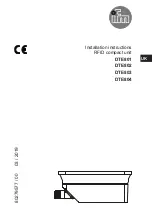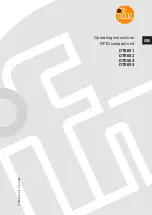
Rev 19.3/9-18
19
VL411LDC: #35162
resulting in stiffness or surface glaze. Pads that exhibit wear, stiffness or glaze must be
replaced.
In addition, all pads should be replaced on a regular basis, preferably after no more than 2 years,
to ensure that the friction coefficient is not compromised. If necessary, contact your dealer or
Wood's Powr-Grip for more information.
Inspection
Inspect each vacuum pad for the following deficiencies routinely, as directed in the preceding
I
NSPECTION
and T
ESTING
S
CHEDULES
. Correct any deficiency before using the lifter.
• Contaminates on the pad face or sealing edges: Soil build-up can prevent pads from sealing
adequately or reduce the friction coefficient (see discussion preceding). Follow the directions
to clean pads as necessary (see discussion to follow).
• Filter screen missing from pad face: This screen helps prevent debris from plugging the
vacuum hose and the air filter. Replace any missing screen immediately (see REPLACEMENT
PARTS LIST).
• Nicks, cuts or abrasions in sealing edges: Pad damage can reduce the lifting capacity of the
lifter. Replace any damaged pad immediately (see REPLACEMENT PARTS LIST).
11
WARNING: Replace vacuum pad if sealing edge has any nicks, cuts or
abrasions.
• Wear, stiffness or glaze: See Friction Coefficient preceding. Replace any pad that exhibits
wear, stiffness or glaze (see REPLACEMENT PARTS LIST).
Cleaning
Regularly clean the face of each vacuum pad to remove oil, dust and any other contaminates.
Acceptable cleaning agents include soapy water and other mild cleansers. Do
not use solvents,
petroleum-based products (including kerosene, gasoline and diesel fuel) or any harsh chemicals
for cleaning. Do
not use unauthorized rubber cleaners or conditioners, such as those intended
for cleaning tires or vinyl surfaces, because those products can leave a hazardous film on vacuum
pads which significantly reduces their lifting capacity (see Friction Coefficient preceding). The
use of any unauthorized cleaning agent is prohibited because it could damage the pad and/or
create a hazard to the operator or others.
WARNING: Never use solvents, gasoline or other harsh chemicals to clean
vacuum pad.
WARNING: Never use unauthorized rubber cleaners or conditioners to clean
vacuum pad.
To prevent liquid from contaminating the vacuum system during cleaning, cover the suction hole
in the recess for the filter screen or make sure the pad faces downward. Use a clean sponge or
lint-free cloth to apply an authorized cleanser and wipe the pad face clean. A toothbrush (or
similar brush with bristles
that do not harm rubber) may be used to remove contaminates
11
If the lifter is equipped with VPFS10T or VPFS625 pads, the sealing edge is the replaceable sealing ring. When it is
damaged, install a new sealing ring insert. In such cases, see T
O
R
EPLACE
S
EALING
R
ING
I
NSERT IN
V
ACUUM
P
AD
to follow.
Summary of Contents for VL411LDC
Page 2: ......
Page 30: ...Rev 19 3 9 18 28 VL411LDC 35162...
Page 31: ...Rev 19 3 9 18 29 VL411LDC 35162...
Page 32: ...Rev 19 3 9 18 30 VL411LDC 35162...














































